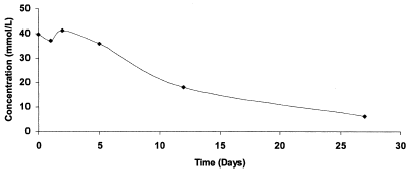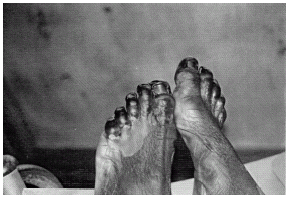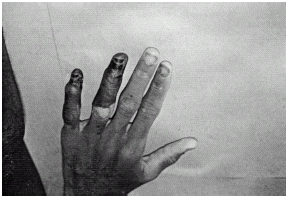Abstract
Hemolytic uremic syndrome (HUS) is not a rare disease. In the tropics with high incidence of diarrhea diseases and their subsequent complications HUS can easily be missed or overlooked. We present a case of HUS highlighting its multi systemic presentation and its management in a resource poor setting where a acute dialysis and plasma exchange are limited in availability and cost.
Introduction
Hemolytic uremic syndrome- Thrombotic thrombocytopenic purpura (HUS-TTP) describes acute syndromes with abnormalities in multiple systems.
Pathologically, the lesions are indistinguishableCitation[[1]] and are a result of thrombotic micro angiopathy. However two distinct clinical entities exist with hemolysis, thrombocytopenia and acute renal failureCitation[[2]] as the hemolytic uremic syndrome and thrombotic thrombocytopenic purpura (TTP) presenting as febrile pleiochromic anemia, petechiae, paralysis, and coma.Citation[[3]] Hemolytic uremic syndrome usually affects young children whereas TTP is more common in adults. In a comparative analysis of adult forms of HUS or TTP, hematological and neurological abnormalities at disease onset were indistinguishableCitation[[4]], Citation[[5]] and adults had similar outcomes as children.
The diagnosis of HUS-TTP is suspected when a patient presents with the following clinical and laboratory findings without another apparent etiologyCitation[[6]]
Microangiopathic hemolytic anemia.
Thrombocytopenia, often with purpura but usually not with severe bleeding.
Acute renal insufficiency that may be associated with anuria and may require acute dialysis.
Neurological abnormalities.
Fever.
However the presence of only thrombocytopenia and microangiopathic hemolytic anemia are required to suspect the diagnosis of HUS-TTP and initiate plasma exchange.Citation[[7]] Additional abnormalities are also frequently observed, including abdominal pain and the presence of a severe neutrophilia in children.
The overall incidence of HUS is estimated at 2.1 cases per 100,000-persons/year with a peak incidence in children under 5 years.Citation[[8]] E. Coli. 0157:H7 contaminated food and water appear to be the most important routes for transmission even though under cooked meat and unpasteurized milk have been implicated.Citation[[9]]
Childhood shiga toxin like-E. Coli. associated HUS usually recovers spontaneously and does not require plasma therapy.Citation[[7]] The general treatment consensus is plasma infusion or exchangeCitation[[7]], Citation[[10]], Citation[[11]] especially in adult HUS-TTP to minimize the risk of death or long-term sequelae. Some authors suggest that when equivalent volumes of plasma were given, infusion and exchange appeared to be equally effective.Citation[[12]]
A 17-year-old male presented with a week's history of abdominal pain and a three-day history of passing more than 20 watery mucoid stools daily. He admitted to vomiting and had a fever. The abdomen was diffusely tender. A diagnosis of infective gastroenteritis was made and antibiotics started.
The patient was anuric at the end of 24 h and had a tonic clonic seizure. A diagnosis of acute renal failure was made and conservative management started. At the end of 72 h patient had become disoriented and drowsy. He was jaundiced, had a tender palpable liver, bilateral subconjunctival hemorrhages, and bleeding gums. All his toes, ring and little fingers on the left hand had become dark. He become progressively dyspneic with an enlarging abdomen over the next 48 h and was found to have a massive right pleural effusion and ascites. The digits now showed well-demarcated dry gangrene.
Table 1. Hematological indices
At this stage a diagnosis of hemolytic uremic syndrome was made. Patient was managed conservatively with maintenance of fluid and electrolyte balance, nutritional support and drainage of pleural effusion. There was no plasma exchange or infusion.
Improvement was remarkable with reversal of renal failure, hepatitis, and ascitic fluid collection. The dry gangrene was referred to the surgical team for further management.
Results
The liver function tests were markedly deranged with enzymes increased to more than ten times, bilirubin raised to about the same levels and being mainly conjugated.
Hemoglobin electrophoresis was AA, blood group B Rhesus positive, direct combs negative, INR of 1.0 and APTT −31 s. Blood and stool cultures were negative, HIV serology negative. Blood film done later in the course of the disease showed marked anisocytosis, poikilocytosis with macrocytes, neutrophilia, and increased platelets.
Discussion
The case described presented with fever, abdominal pain diarrhea and vomiting leading to acute renal shut down with an acute drop in hemoglobin postulated to have been caused by hemolysis. Subsequent involvement of other systems namely the central nervous system, hepatobiliary, respiratory, and vasculitis with thrombocytopenia suggested the diagnosis of HUS-TTP.
Disseminated intravascular coagulation was excluded on grounds of normal APTT and INR. There were no facilities for testing fibrinogen and fibrin degradation products. Autoimmune hemolytic anemia was also excluded, as the direct combs test was negative. Other systemic vasculitides were excluded on account of absence of arthralgia, and a rash, proteinuria, and hematuria.
The classical blood picture is microangiopathic hemolysis but a blood film done quite late in the course of the disease showed anisocytosis, poikilocytosis with some macrocytes, and increased platelets.
The symptoms presented by the patient could be attributed to food poisoning of which E. coli. is potential pathogen. Hemolytic uremic syndrome is usually diagnosed six days after the onset of the diarrhea,Citation[[1]] which is what was observed in this case.
The case under discussion was treated conservatively. Acute renal failure was treated without dialysis, treatment included diet, salt and water balance, and diuretics. Acute hepatitis was treated with rest, fluid balance, diet, and vitamins and at a stage neomycin for bowel sterilization and magnesium sulfate as a laxative. Pleural effusion was drained, ascites resolved and patient improved.
E. coil. associated HUS-TTP is not a benign disease and in older patients a mortality rate close of 90% has been reported, 13 in the absence of recommended treatment. This patient's survival could be attributed to a presentation similar to childhood HUS. Better supportive management is believed to have decreased the mortality rate in childhood HUS from 40–50% over the last 40 years to 4–13% presently.Citation[[14]] This has also improved prognosis in adults.
A 20-year review of hemodialysis in the treatment of Acute Renal Failure in Tropical Africa.Citation[[15]] Mate-Kole et al. found no cases of HUS-TTP. This could imply rarity of the disease or missed diagnosis. Highlighting this case would encourage physicians to look for cases of HUS-TTP.
References
- Piero Ruggenenti, Marina Nons, Giuseppe Remuzzi. Thrombotic micro angiopathy hemolytic uremic syndrome and thrombotic thrombocytopenic purpura. Kidney Int. 2001; 60: 831–846
- Gasser C., Gautier E., Steck A. Hemolytisch-Uramische syndromes bilaterale nierenrindennekrosen bei akuten erworbencten haemolyrischen anamien. Schweiz med Wschr 1995; 85: 905–909
- Moschcowitz E. Acute febrile pleiochromic anemia with hyaline thrombosis of a terminal arterioles and capillaries. An undescribed disease. Arch. Intern. Med. 1925; 36: 89–93
- Rock G., Shumak K., Buskard N.A. Comparison of plasma exchange with plasma infusion in the treatment of thrombocytopenic purpura. N. Engl. J. Med. 1991; 325: 393–397
- Rock G., Shumak K., Kelton J. Thrombotic thrombocytopenic purpura. Outcome in 24 patients with renal impairment treated with plasma exchange. Transfusion 1992; 32: 710–714
- Seigler R., Berry P.L., Hogg R.L. Comparison of the epidemiologic and clinical features of endemic and sporadic forms of hemolytic uremic syndrome (HUS) in 210 USA children. Report of the Southwest Pediatric Nephrology Study Group (abstract). Kidney Int. 1986; 29: 1086
- George J.N. How I treat patients with thrombotic thrombocytopenic purpura-hemolytic uremic syndrome (in process citation). Blood, 96: 1229–2000
- Su C., Brandt L.J. Escherichia coli 0157: H7 infection in humans. Ann. Intern. Med. 1991; 123: 698–714
- Pavia A.T., Nichols C.R., Green D.R. Hemolytic uremic syndrome during an outbreak of Escherichia coli 0157; H7 infections in institutions for mentally retarded persons. Clinical and epidemiologic observations. J. Pediatr. 1990; 116: 554–551
- Remuzzi G., Ruggenenti P. The hemolytic uremic syndrome. Kidney Int. 1995; 47: 2–19
- Ruggenenti P., Remuzzi G. Treatment of thrombotic micro angiopathy. Nephro 1995; 18: 255–272
- Novitzky N., Jacobs P., Rosenstrauch W. The treatment of thrombotic thrombocytopenic purpura. Plasma infusion or exchange?. Br. J. Hematol. 1994; 87: 317–320
- Carter A.O., Borczyk A.A., Cerlson J.A. A severe outbreak of Escherichia coli 0157:H7 associated hemorrhagic colitis in a nursing home. N. Engl. J. Med. 1987; 317: 1496–1550
- Remuzzi G. Hemolytic uremic syndrome and thrombotic thrombocytopenic purpura. 15th Annual Conrad C Pirani Lecture. Sep, 1998, 16–19
- Mate-Kole M.O., Yeboah E.D., Affram R.K. Hemodialysis in the treatment of acute renal failure in tropical Africa: a 20-year review at the Korle-Bu teaching hospital. Accra. Renal Failure 1996; 18(3)517–524


